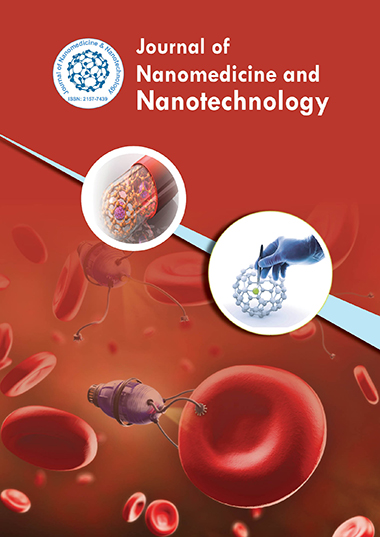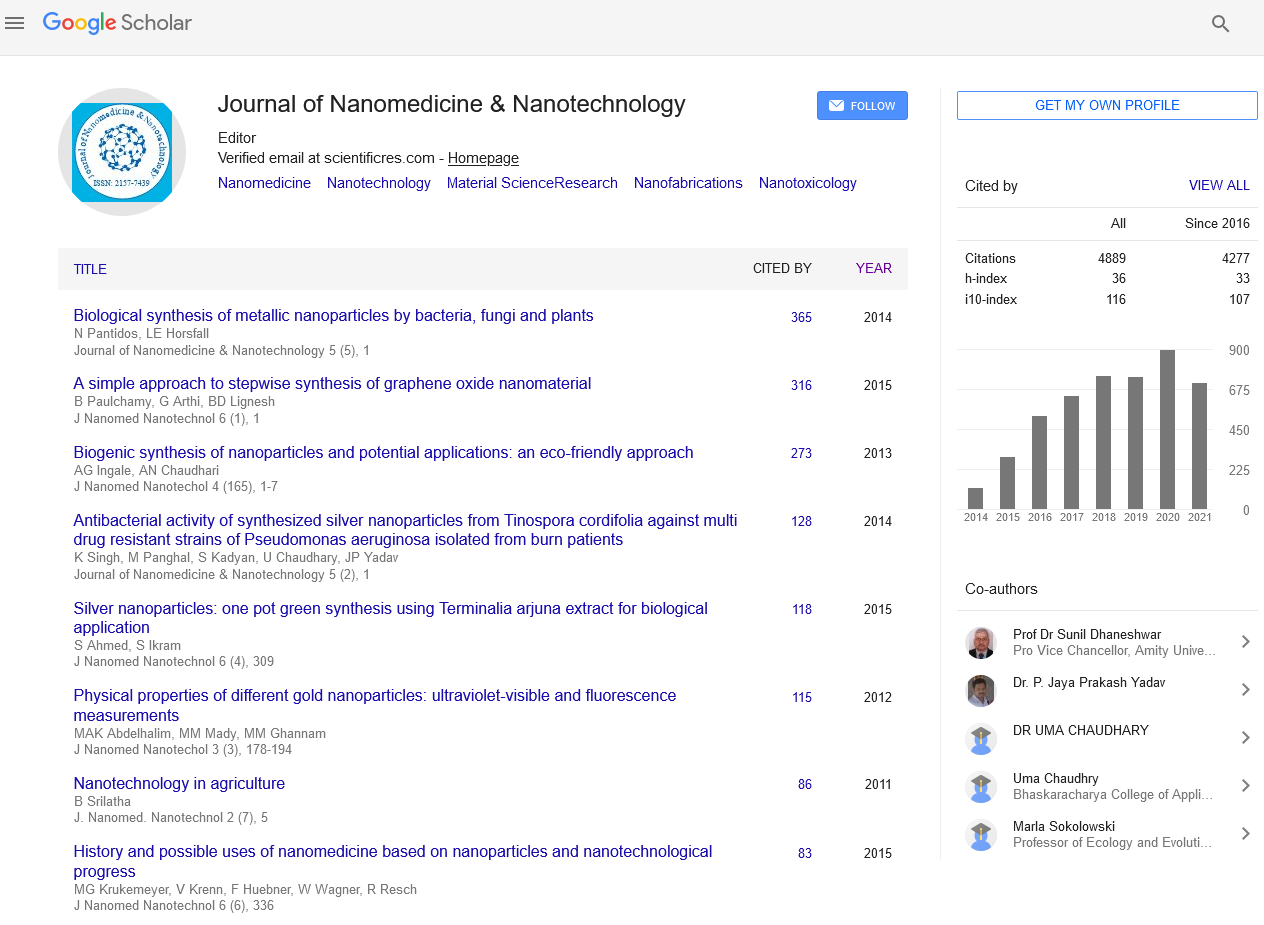Indexed In
- Open J Gate
- Genamics JournalSeek
- Academic Keys
- JournalTOCs
- ResearchBible
- China National Knowledge Infrastructure (CNKI)
- Scimago
- Ulrich's Periodicals Directory
- Electronic Journals Library
- RefSeek
- Hamdard University
- EBSCO A-Z
- OCLC- WorldCat
- SWB online catalog
- Virtual Library of Biology (vifabio)
- Publons
- MIAR
- Scientific Indexing Services (SIS)
- Euro Pub
- Google Scholar
Useful Links
Share This Page
Journal Flyer

Open Access Journals
- Agri and Aquaculture
- Biochemistry
- Bioinformatics & Systems Biology
- Business & Management
- Chemistry
- Clinical Sciences
- Engineering
- Food & Nutrition
- General Science
- Genetics & Molecular Biology
- Immunology & Microbiology
- Medical Sciences
- Neuroscience & Psychology
- Nursing & Health Care
- Pharmaceutical Sciences
Editorial - (2024) Volume 15, Issue 5
Smart Nanocarriers for Controlled Drug Release: Mechanisms and Applications
Lukas Müller*Received: 03-Sep-2024, Manuscript No. jnmnt-24-27136; Editor assigned: 05-Sep-2024, Pre QC No. jnmnt-24-27136 (PQ); Reviewed: 20-Sep-2024, QC No. jnmnt-24-27136; Revised: 24-Sep-2024, Manuscript No. jnmnt-24-27136 (R); Published: 30-Sep-2024, DOI: 10.35248/2157-7439.24.15.750
Abstract
Smart nanocarriers represent a significant advancement in drug delivery systems, offering controlled release of therapeutic agents in response to specific stimuli. These nanocarriers enhance the efficacy and safety of treatments by ensuring that drugs are released at the right time and place within the body. This article reviews the various types of smart nanocarriers, their mechanisms of action, and their applications across different therapeutic areas, particularly in oncology, chronic diseases, and gene therapy. The potential future directions for research in this dynamic field are also discussed.
Keywords
Smart Nanocarriers; Controlled Drug Release; Stimuli-Responsive Systems; Drug Delivery; Oncology; Gene Therapy; Nanomedicine
INTRODUCTION
The field of nanomedicine has made remarkable progress in recent years, particularly in drug delivery systems that enhance therapeutic efficacy while minimizing side effects. Traditional drug delivery methods often suffer from issues related to poor bioavailability and non-specific distribution, leading to suboptimal therapeutic outcomes. Smart nanocarriers, designed to release drugs in a controlled manner in response to specific physiological or pathological stimuli, offer a promising solution [1]. This article explores the mechanisms of action, types, and applications of smart nanocarriers in controlled drug release.
MECHANISMS OF SMART NANOCARRIERS
Smart nanocarriers can be classified based on the stimuli they respond to, including chemical, physical, and biological triggers. The most common mechanisms include
pH Responsive Release
Many smart nanocarriers are designed to release their payload in response to pH changes, capitalizing on the differences between normal and pathological tissues. For example, tumors oftenS exhibit a lower extracellular pH (around 6.5) compared to healthy tissues (around 7.4) [2]. pH-sensitive polymers, such as polyacrylic acid (PAA), can swell or degrade in acidic environments, allowing for the controlled release of encapsulated drugs. This mechanism has been extensively studied for the targeted delivery of anticancer agents.
Temperature-Responsive Release
Temperature-sensitive nanocarriers can release drugs when exposed to specific temperature changes. This approach is particularly useful for localized therapies, such as in hyperthermia treatment for tumors. For instance, poly(N-isopropylacrylamide) (PNIPAM) undergoes a phase transition at around 37°C, enabling the release of drugs at body temperature [3]. Researchers have investigated temperature-sensitive liposomes that release their contents upon heating, providing targeted treatment with minimal side effects.
Enzyme-Responsive Release
Enzyme-responsive nanocarriers are designed to release drugs in the presence of specific enzymes that are overexpressed in certain disease states. For example, matrix metalloproteinases (MMPs), which are upregulated in many cancers, can trigger the release of therapeutic agents from nanocarriers modified with MMP-sensitive linkers. This targeted approach enhances drug accumulation in tumor tissues while reducing systemic exposure.
Light-Responsive Release
Light-triggered drug release offers precise spatial and temporal control over therapeutic delivery. Nanocarriers can be engineered to contain photosensitive materials that undergo conformational changes upon exposure to specific wavelengths of light [4]. For example, azobenzene-based systems can switch from a hydrophobic to a hydrophilic state under UV light, releasing their drug payload. This mechanism allows for localized drug delivery and minimizes off-target effects.
TYPES OF SMART NANOCARRIERS
Polymeric Nanoparticles
Polymeric nanoparticles are widely used as smart nanocarriers due to their tunable properties and biocompatibility. Various polymers, such as PLGA and chitosan, can be modified to achieve stimuli-responsive characteristics [5]. These nanoparticles can encapsulate a range of therapeutic agents, from small molecules to proteins, allowing for versatile applications in drug delivery.
Liposomes
Liposomes, lipid-based vesicles that encapsulate drugs, can be designed to respond to specific stimuli. For instance, pH-sensitive liposomes can release their payload in acidic environments, making them ideal for cancer therapy. Additionally, light-sensitive liposomes can provide controlled release in targeted areas using external light sources.
Dendrimers
Dendrimers are highly branched, nanoscale macromolecules that offer precise control over drug loading and release. Their architecture allows for multiple functionalization options, enabling the development of stimuli-responsive systems [6]. Dendrimers can be designed to release their therapeutic payloads in response to specific enzymes or pH changes, making them suitable for targeted therapies.
Metal Nanoparticles
Metal nanoparticles, such as gold and silver nanoparticles, have unique optical properties that can be exploited for controlled drug release. These nanoparticles can be conjugated with drugs and designed to release their payload upon exposure to specific wavelengths of light. This approach is particularly effective for photothermal therapy in cancer treatment.
APPLICATIONS OF SMART NANOCARRIERS
Oncology
Smart nanocarriers have shown significant promise in cancer therapy by delivering chemotherapeutic agents directly to tumor sites. For example, pH-sensitive nanoparticles have been developed to encapsulate doxorubicin, releasing the drug specifically in the acidic tumor microenvironment [7]. This targeted approach not only enhances therapeutic efficacy but also reduces side effects associated with conventional chemotherapy.
Chronic Diseases
In chronic diseases such as diabetes and arthritis, smart nanocarriers can provide sustained release of therapeutic agents, improving patient compliance and treatment outcomes. For instance, insulin-loaded nanoparticles that respond to glucose levels can offer a controlled release of insulin, allowing for better management of blood sugar levels.
Gene Therapy
Smart nanocarriers play a crucial role in gene therapy by delivering nucleic acids to target cells. For instance, enzyme-responsive nanoparticles can release siRNA in the presence of specific enzymes overexpressed in certain cancers, facilitating targeted gene silencing. This targeted delivery enhances the efficacy of gene therapies while minimizing off-target effects.
Vaccination
Smart nanocarriers are also being explored in vaccination strategies, where they can provide controlled release of antigens [8]. This approach can enhance immune responses by ensuring that the antigen is released in a controlled manner, leading to improved vaccine efficacy.
FUTURE DIRECTIONS
The field of smart nanocarriers for controlled drug release is rapidly evolving, with several promising future directions:
Personalized Medicine
The integration of smart nanocarrier technologies with personalized medicine can revolutionize treatment strategies. By tailoring nanocarriers to individual patient profiles, including genetic and molecular characteristics, more effective and safer therapies can be developed [9].
Combination Therapies
Combining different therapeutic agents in a single smart nanocarrier can enhance treatment efficacy. For example, co-delivery of chemotherapeutic agents and immunotherapeutics can target tumors from multiple angles, improving therapeutic outcomes.
Advanced Imaging Techniques
The incorporation of imaging agents within smart nanocarriers can facilitate real-time monitoring of drug release and distribution. This integration can provide valuable insights into the pharmacokinetics of therapies, allowing for better optimization of treatment regimens.
Regulatory Considerations
As smart nanocarriers advance toward clinical application, addressing regulatory challenges will be crucial. Establishing clear guidelines for the evaluation of safety, efficacy, and quality will help facilitate the translation of these innovative therapies from the laboratory to the clinic [10].
CONCLUSION
Smart nanocarriers represent a transformative approach in drug delivery, enabling controlled release of therapeutic agents in response to specific stimuli. By enhancing targeting and minimizing side effects, these systems hold great promise in various therapeutic areas, particularly in oncology and chronic diseases. Continued research and development in this field will pave the way for the next generation of therapeutic strategies, ultimately improving patient outcomes and advancing the future of medicine.
REFERENCES
- Li Y, Wang Y, Huang G, Gao J, Cooper I R, Ji J, et al. Recent progress in smart drug delivery nanosystems using stimuli-responsive polymers. J Mater Chem B. 2019; 7(8): 1139-1161.
- Miao L, Huang L, Exploring N. Nano-enabled delivery of RNAi and CRISPR-Cas9 for cancer treatment. Nano Today. 2020; 32: 100853.
- Wang Z, Li X, Ying Z. Combining Magnetic Nanoparticles and Ultrasound for Drug Delivery in Cancer: A Comprehensive Review. Crit Rev Oncol Hematol. 2018; 131: 34-49.
- Qin B, Pei J, Guo H, Dong X, Zong B, Li D. Bioinspired nanoparticles for direct intratumoral chemotherapy of local cancer. J Mater Chem B. 2019; 7(23): 3646-3652.
- Shi Y, van Steenbergen M J, Teunissen A J P, van der Meel R, Lammers T. Drug delivery strategies for platinum-based anticancer drugs. Expert Opin Drug Deliv. 2020; 17(5): 587-604.
- Ma D, Zhang, H B, Shu W. Integration of a Nanocarrier-Based Platform for Dual-Responsive Cocktail Chemotherapy and Dual-Modal Imaging. Advanced Materials. 2019; 31(12): 1807887.
- Hobbs S K, Monsky, W L, Yuan F, Roberts W G, Griffith L, et al. Regulation of transport pathways in tumor vessels: Role of tumor type and microenvironment. Proc Natl Acad Sci. 2018; 95(8): 4607-4612.
- Dong Y, Love K T, Dorkin J R, Sirirungruang S, Zhang Y, Chen D, et al. Lipopeptide nanoparticles for potent and selective siRNA delivery in rodents and nonhuman primates. Proc Natl Acad Sci. 2018; 111(11): 3955-3960.
- Lentacker I, Geers B, Demeester J. De Smedt, S. C. Advanced Delivery Strategies for Anticancer Nanomedicine. Nanomedicine. 2021; 7(2): 179-196.
- Kieran D, Woods A, Villalta-Cerdas A, Weiner S. Tumor-associated antigens for the induction of antitumor immune responses. Annual Review of Immunology. 2020; 39: 251-272.
Indexed at, Google Scholar, Crossref
Indexed at, Google Scholar, Crossref
Indexed at, Google Scholar, Crossref
Indexed at, Google Scholar, Crossref
Indexed at, Google Scholar, Crossref
Indexed at, Google Scholar, Crossref
Indexed at, Google Scholar, Crossref
Indexed at, Google Scholar, Crossref
Citation: Lukas M (2024) Smart Nanocarriers for Controlled Drug Release Mechanisms and Applications. J Nanomed Nanotech. 15: 750.
Copyright: ©2024 Lukas M. This is an open-access article distributed under the terms of the Creative Commons Attribution License, which permits unrestricted use, distribution, and reproduction in any medium, provided the original author and source are credited.
Competing interests: The authors have declared that no competing interests exist.


